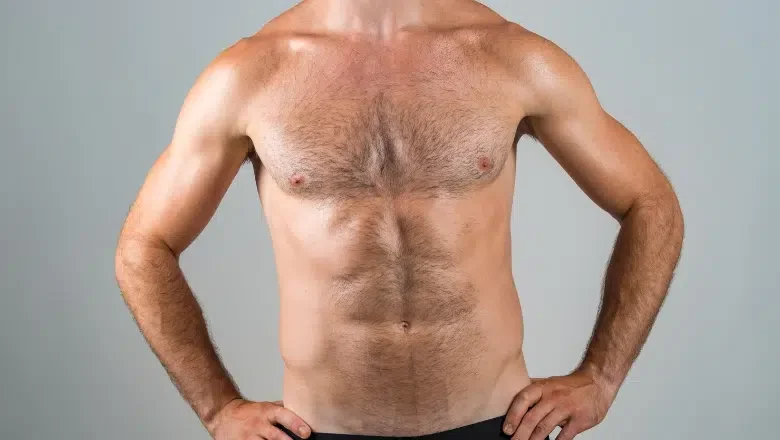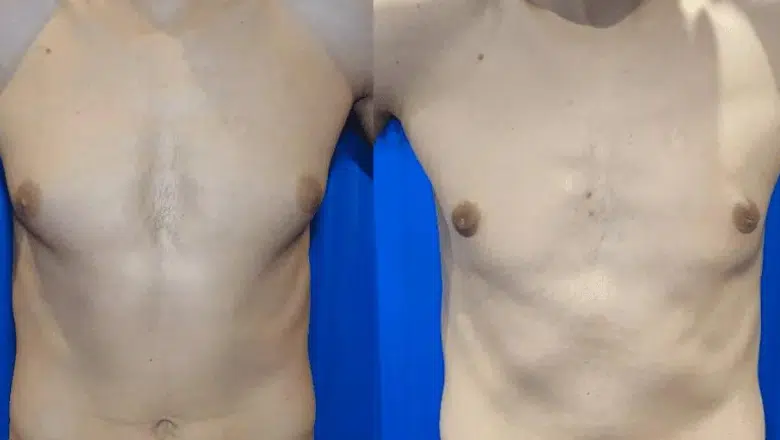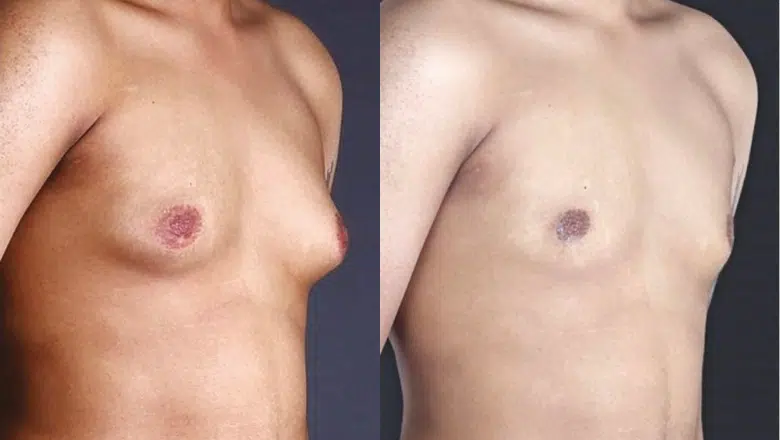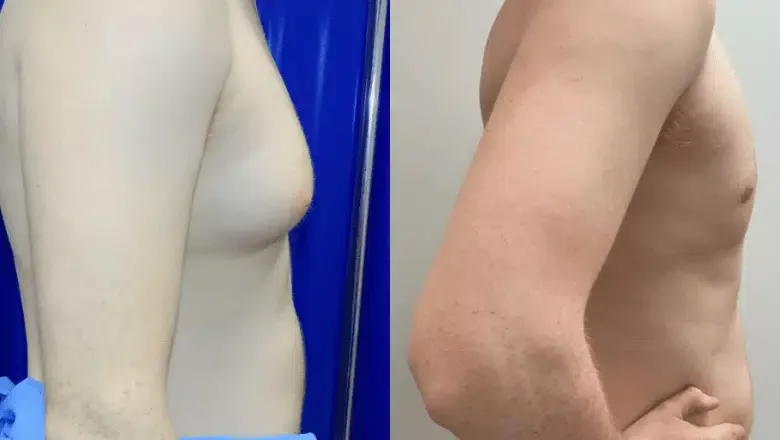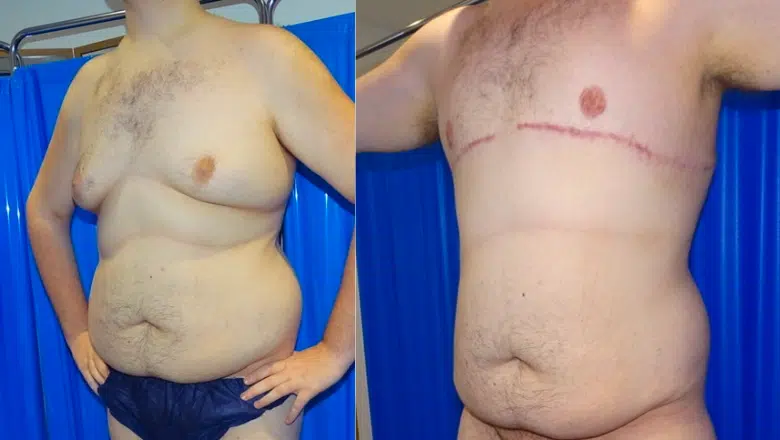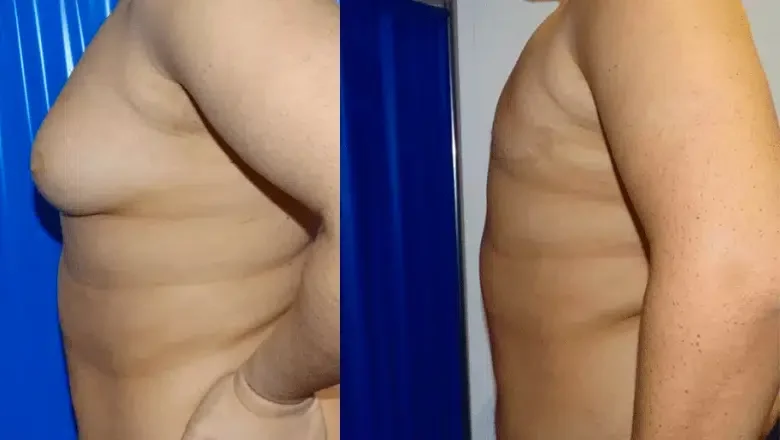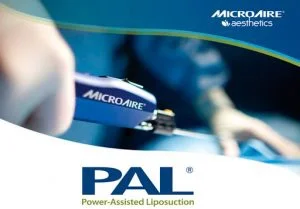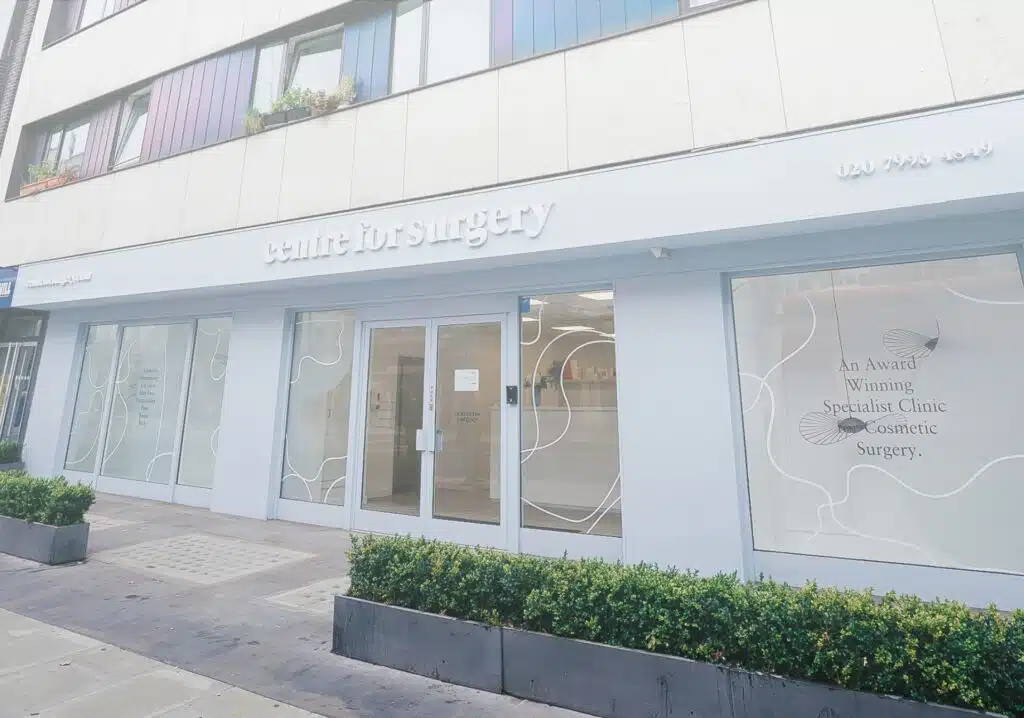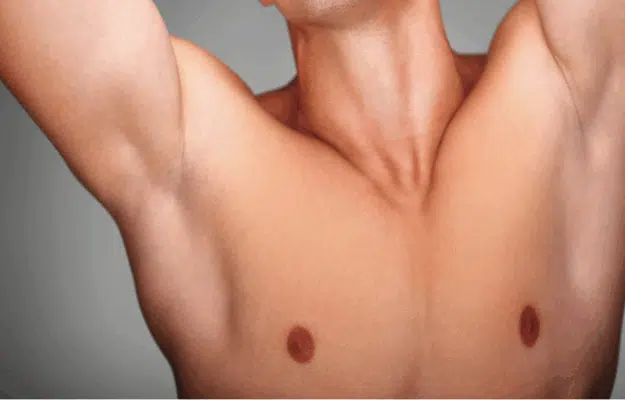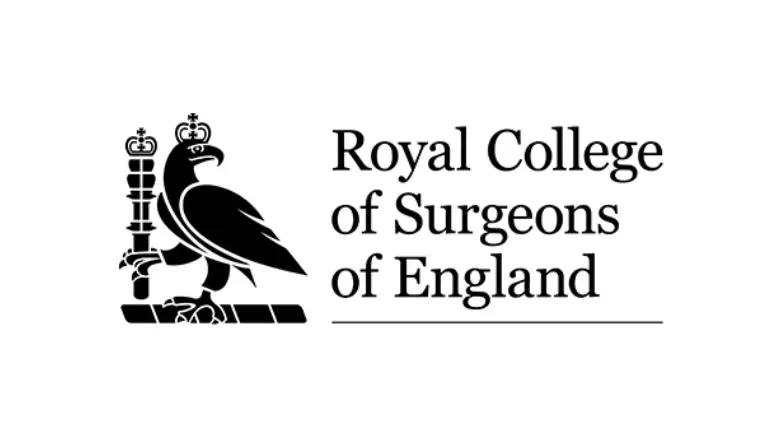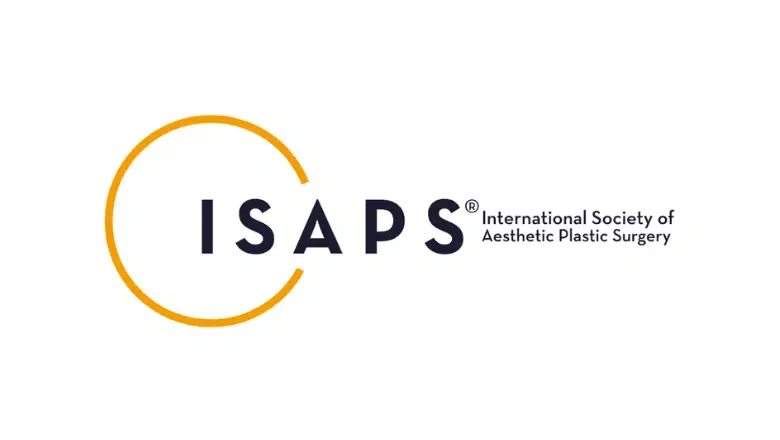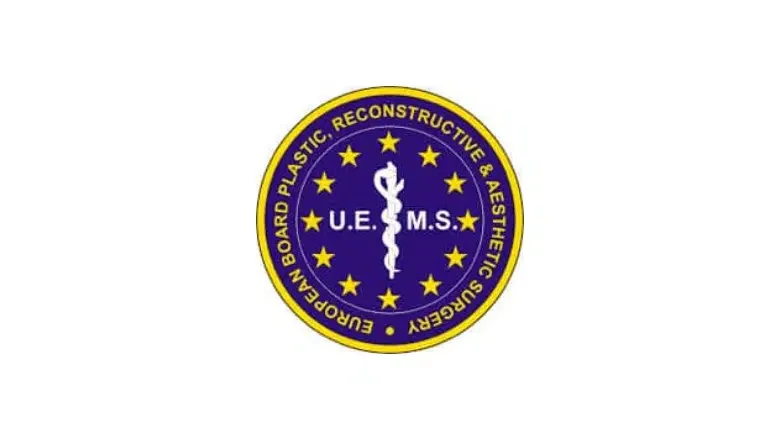Male Breast Reduction in London
Feel comfortable and confident in your own skin with male chest reduction – a personalised procedure designed to reduce excess breast tissue and restore a more masculine chest contour for a more confident you.
Enlarged male breasts or ‘man boobs’ are a common condition among men, with an estimated 40 to 60 per cent of men in the UK experiencing breast tissue enlargement at some point in their lives. While it is a common condition, it can have a significant impact on an individual’s self-esteem and quality of life. Many men with gynecomastia feel self-conscious or embarrassed about their appearance and may avoid situations that require them to expose their chest.
RELATED: Male Chest Reduction Surgery in London
The emotional impact of gynecomastia can be significant, and it’s not uncommon for men to feel uncomfortable or anxious about their bodies. They may choose to wear loose-fitting clothing to hide their breast tissue or avoid activities that require them to remove their shirt. This can lead to social isolation and a diminished sense of self-confidence.
Fortunately, male breast reduction surgery or gyno surgery can be an effective solution for men with man boobs. This procedure involves the removal of excess breast tissue and fat, which can restore a more masculine chest contour. The surgery is typically performed on an outpatient basis and involves minimal scarring.
RELATED: Can Gyno Surgery Get Rid Of Man Boobs?
For many men, male breast reduction surgery can be a life-changing experience. It can help them feel more comfortable and confident in their bodies, allowing them to enjoy activities and social situations that they may have avoided before. If you are struggling with gynecomastia and its impact on your quality of life, it may be worth considering male breast reduction surgery as a way to regain your confidence and improve your self-esteem.
RELATED: Gynecomastia Surgery FAQs – Q&As about Male Breast Reduction
Male breast reduction surgery is the surgical solution for those who have gynecomastia. Male breast reduction surgery involves a combination of procedures, which include liposuction, gland removal, or skin reduction.
| Male Breast Reduction | Fast Facts |
|---|---|
| Procedure time ⏳ | 1-3 hours |
| Anaesthetic type 💉 | GA or LA |
| Length of stay 🛏 | Day case |
| Up and mobile 🚶🏻♂️ | Same day |
| Washing 🛁 | 3 days |
| Travel ✈️ | 2 weeks |
| Sexual activity ❤️ | 2 weeks |
| Driving 🚗 | 2 weeks |
| Postoperative garment 👕 | 6 weeks |
| Sleeping 😴 | on back 1 week |
| Exercise 🏃🏽♀️ | 4 weeks |
| Full recovery 🕺🏻 | 6 weeks |
| Final results 😃 | 3 months |
What is Enlarged Male Breast Tissue?
Gynecomastia, the medical term for “enlarged male breasts” or “man boobs”, is a common condition among men. It can develop at various times in life and for a variety of reasons. In infant boys, it’s usually the result of being exposed to excess hormones from the mother during pregnancy or breastfeeding. However, this usually disappears as the infant grows. Teenage boys can develop enlargement of one or both breasts as a result of hormonal changes during puberty. However, this also often disappears after puberty.
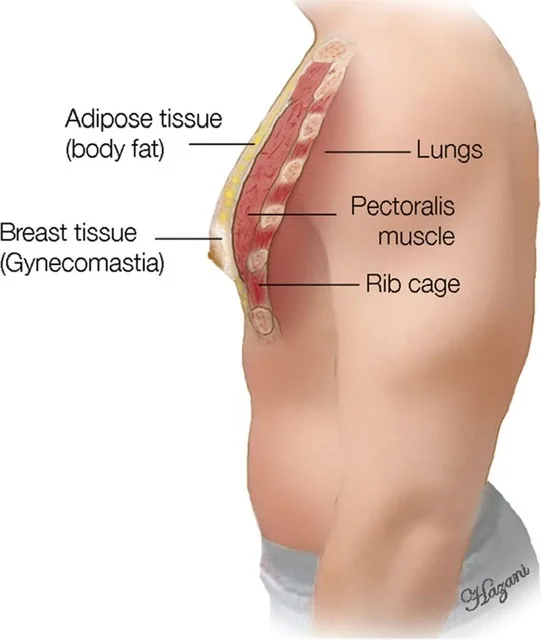
Gynecomastia becomes a problem in men when enlarged breasts develop and never go away. Most of the time, this results from weight gain and fat accumulation in the chest region. However, enlarged breasts can consist of glandular tissue at times. Sometimes man boobs are the result of changes in hormones with age, but it is rare. Enlarged breasts in men can also be caused by medical conditions, such as tumours, kidney disease, or liver disease. However, excessive weight gain is the most common reason for the development of man boobs. And for this, male breast reduction liposuction is an option.
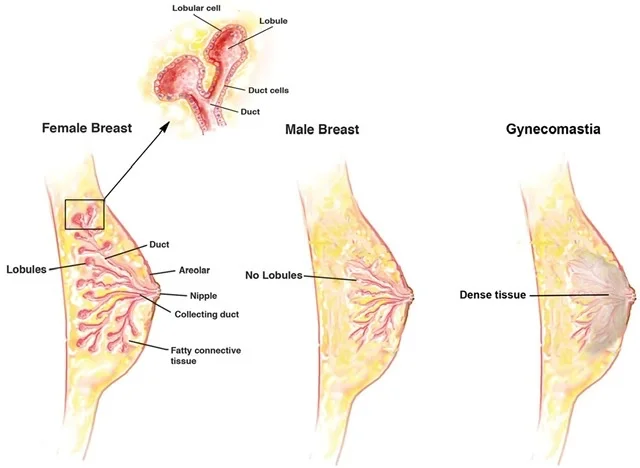
If you have overdeveloped breasts and feel self-conscious about the appearance of your chest, liposuction with or without surgical excision can correct the problem. Liposuction with surgical excision is a highly effective treatment for the removal of the localised excess fatty and glandular tissues in the breast region. This creates a leaner, flatter appearance.
What causes Enlarged Male Breast Tissue?
- Advanced age – men develop hormonal changes after the age of 55
- Puberty – excessive enlargement of the male breast can occur during puberty but usually tends to resolve after one or two years
- Obesity – With a gain in weight – excess fat may stimulate oestrogen levels to rise, which in turn stimulates male breast growth
- Excessive alcohol intake – the liver can be affected, which can subsequently affect hormone levels with an increase in breast tissue growth
- Genetic predisposition
- Certain medications (see FAQs below)
How is Gynecomastia Diagnosed?
The diagnosis of gynecomastia usually involves a combination of medical history, physical examination, and diagnostic tests. Here are the steps that could be taken to diagnose gynecomastia:
Medical History
Your doctor will begin by taking a medical history, including any symptoms the patient is experiencing and any medications they are taking. They will also ask about the patient’s medical history, including any conditions that may be causing the breast enlargement.
Physical Examination
A healthcare provider will perform a physical examination of the chest area to look for signs of breast tissue enlargement. They may also examine the genitals and testicles to check for any abnormalities that may be causing the condition.
Blood Tests
Blood tests may be ordered to check hormone levels, liver function, and kidney function. These tests can help identify any underlying medical conditions that may be causing the breast enlargement.
Imaging Tests
Imaging tests, such as mammography, ultrasound, or MRI, may be ordered to evaluate the breast tissue and rule out breast cancer.
Biopsy
In rare cases, a biopsy may be needed to determine the cause of the breast enlargement. During a biopsy, a small amount of breast tissue is removed and examined under a microscope.
Gynecomastia vs Pseudogynecomastia
Pseudogynecomastia most commonly occurs in overweight and obese men, where the chest enlargement is mostly due to excess fatty tissue around or underneath the nipple-areolar complex. In true gynecomastia, excess fat and glandular tissue are in the breast.
RELATED: Gynecomastia vs Chest Fat – How to Tell the Difference
The distinction is important as pseudogynecomastia often responds well to liposuction alone compared with true gynecomastia, which often requires a combination of both liposuction and surgical excision of the breast glandular tissue.
RELATED: Gynecomastia vs Pseudogynecomastia
Male Breast Reduction Before & After Photos
Gynecomastia surgery can lead to a significant improvement in the appearance of your chest and an increase in self-confidence but it may not necessarily lead to exactly what you wanted. For any patient considering having surgery, it is important to have realistic expectations of what gynaecomastia correction can achieve and discuss them openly with your London gynecomastia treatment specialist.
RELATED: Gynecomastia Surgery Before & After Photos
The results of gynecomastia correction are both significant and permanent in nature. For those with realistic expectations, you will be more likely to be very pleased with the results of the male breast reduction procedure.
Please see the before and after gallery below to get an in-depth understanding of the results that can be achieved with other patients. When you have a consultation with one of our specialist plastic surgeons, you will be able to view a larger collection of gynecomastia before and after photos.
Before and After Gynecomastia
Case 1:
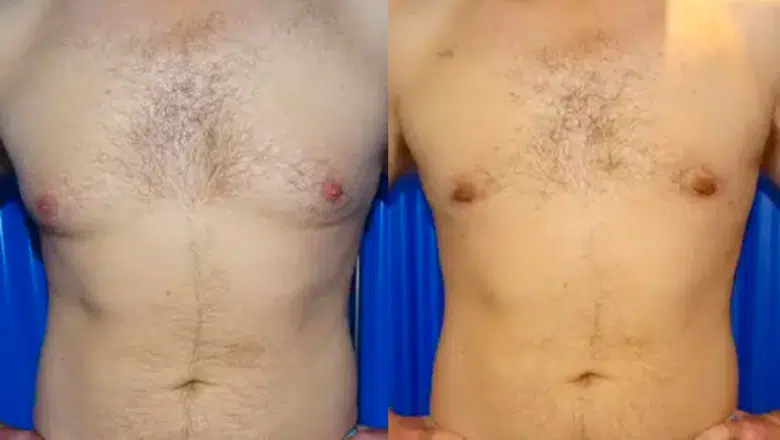
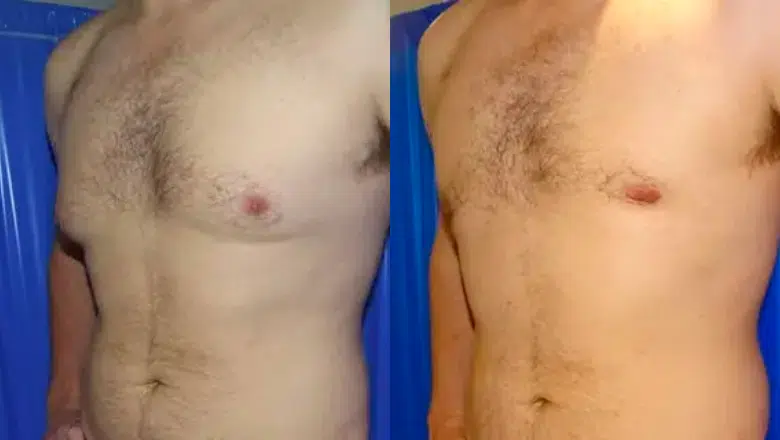
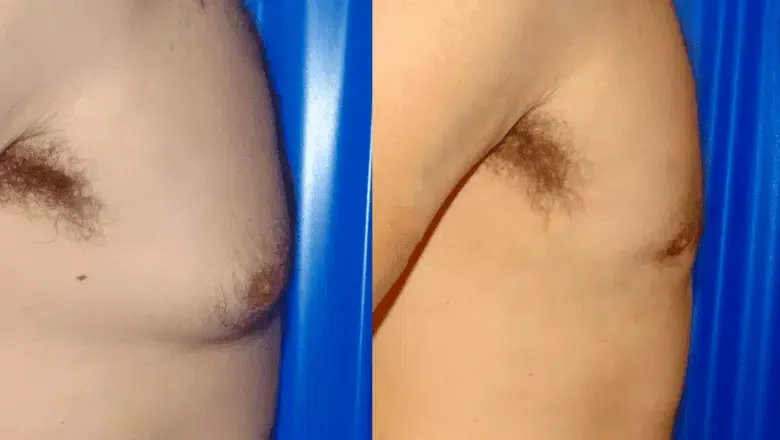
Case 2:
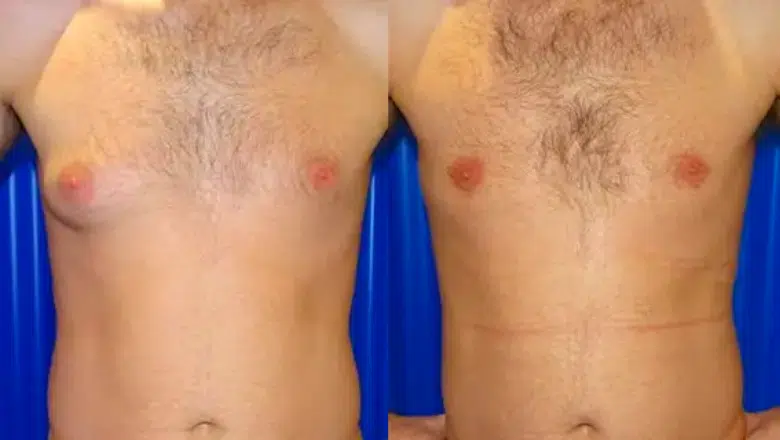
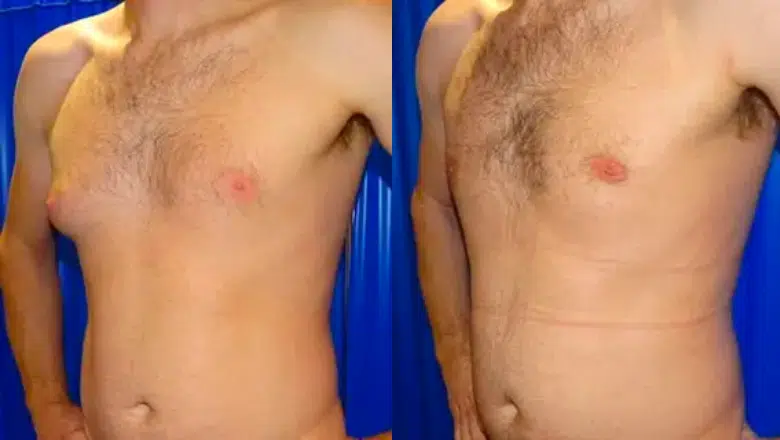

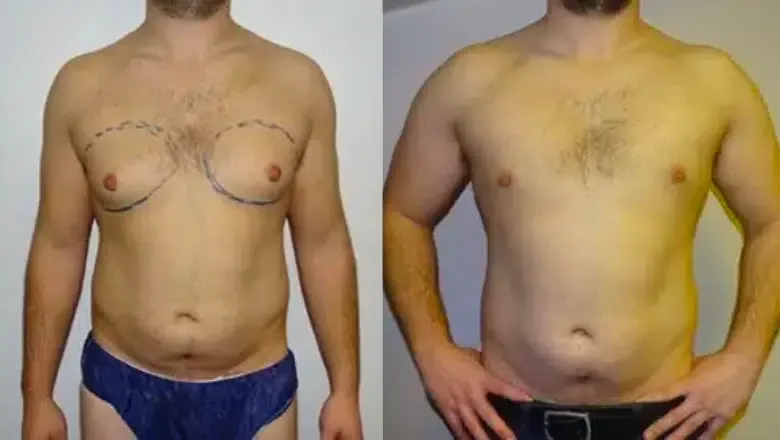
Case 4:
Case 5:
Case 6:
Case 7: 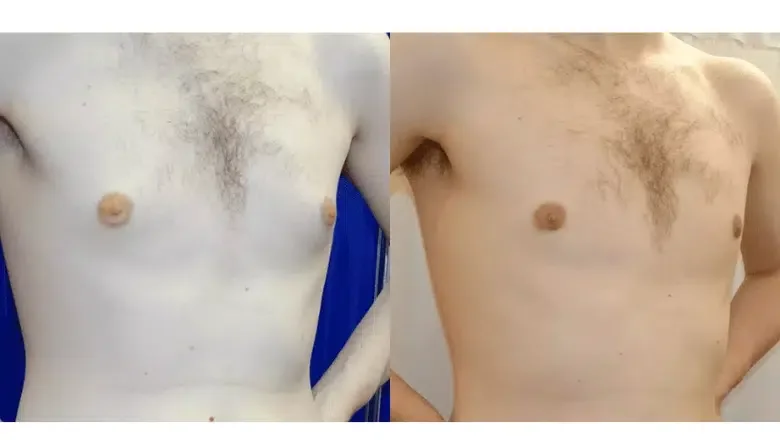
Case 8:

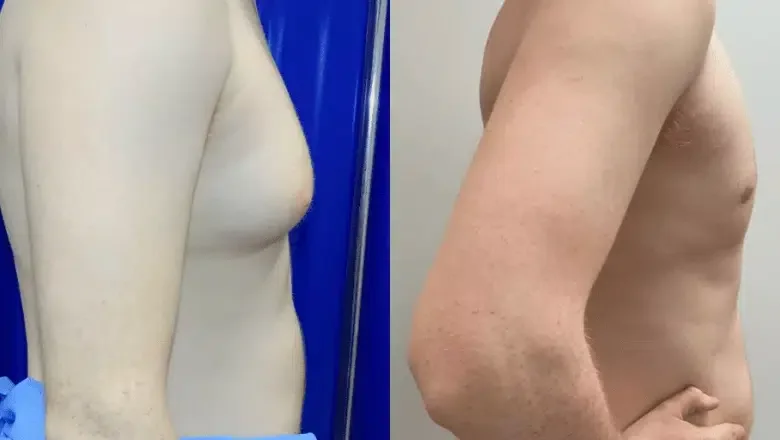
Case 9:
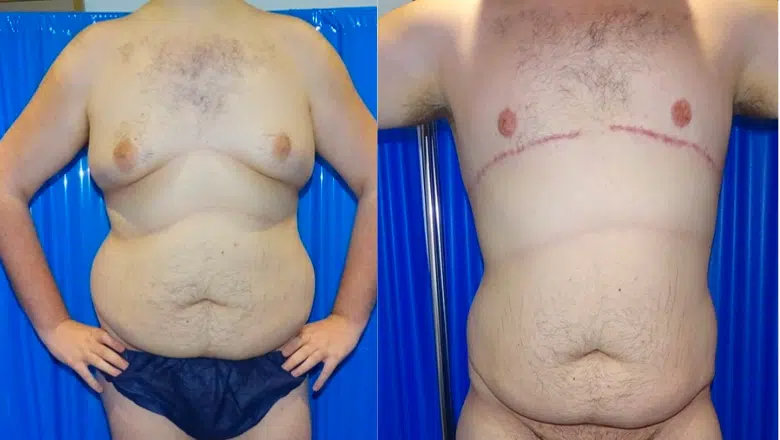
Case 11:
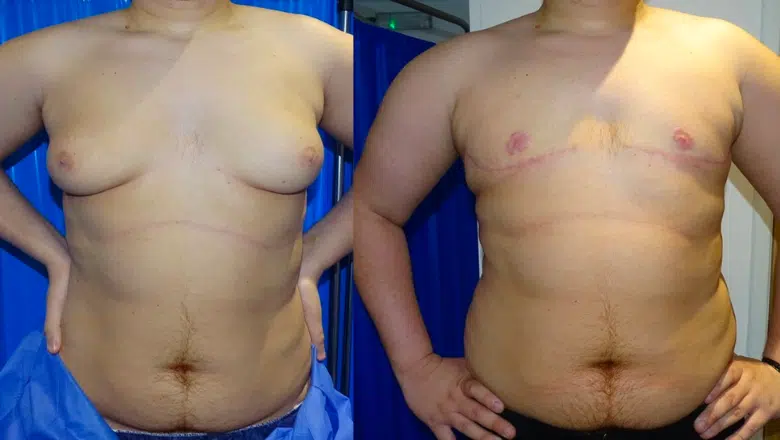
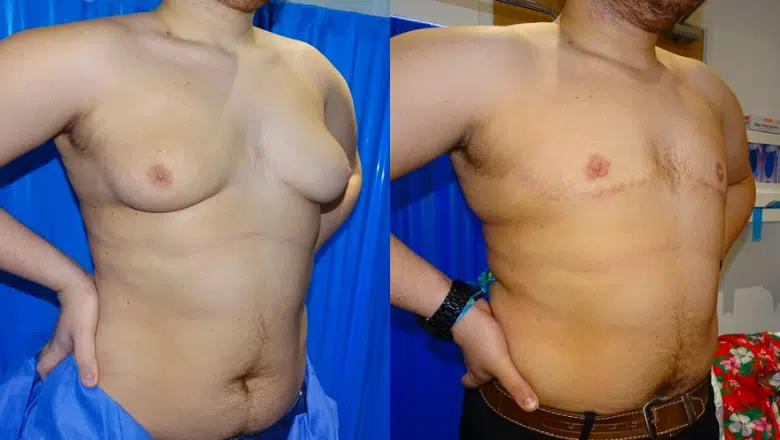
Ideal candidates for Male Breast Reduction
A good candidate for male chest reduction will have a positive outlook and realistic expectations of the outcome of the procedure. He will be undergoing male breast reduction for personal reasons, and not to satisfy anyone else.
There is no optimum age for a male breast reduction patient, but he should have skin with enough elasticity so that it will contour well to the chest’s new shape. Older patients have sometimes lost elasticity in their skin, so their results won’t be as satisfactory when compared with younger patients.
A good candidate for male breast reduction should be as close to his ideal weight as possible. Being overweight can contribute to gynecomastia, so try to lose weight with diet and exercise before you pursue surgery. Also, non-smokers are better candidates than smokers because smoking interferes with the healing process. If you smoke, you will need to quit at least six weeks before surgery.
If you are considering having male breast reduction surgery, you may wish to explore the finance options we offer.
Questions to ask during your gynecomastia consultation
Having a consultation with a specialist surgeon skilled in gynecomastia surgery is the ideal opportunity to ask all the important questions to enable you to fully understand what the procedure involves before making an informed decision on proceeding with surgery. At the Centre for Surgery, we always emphasise consultation as the foundation of treatment planning to ensure you get the very best outcomes following male chest reduction.
RELATED: How To Get Rid Of Gynecomastia
The following questions serve as a useful guide which you could ask at your consultation:
- Am I a suitable patient for male breast reduction?
- Do I have realistic expectations, given the size and shape of my chest?
- Is one procedure enough to achieve the results I’m looking for, or will I need a staged treatment approach?
- Do you have male breast reduction before and after photos of men who have undergone a similar gynecomastia removal procedure?
- What is the recovery like after gynecomastia correction?
- How often will the clinical support team contact me to check up on how I am doing?
- What are the side effects of gynecomastia surgery in terms of swelling, bruising and scarring?
- What happens if I am unhappy with the outcome of the male gyno procedure?
Preparing for Male Breast Reduction
If you are planning to undergo male breast reduction surgery to correct gynecomastia, it’s important to prepare yourself both physically and mentally. At Centre for Surgery, we understand the importance of proper preparation and will work closely with you to ensure that you are fully prepared for your surgery.
During your initial consultation, our surgeon will meet with you to obtain your health history and perform a thorough physical examination. This is an essential step in the preparation process, as it helps to identify any underlying medical conditions that may affect your surgery or recovery. Our surgeon will also discuss your goals and expectations for the procedure and provide you with a realistic understanding of what can be achieved through gynecomastia surgery.
In addition to the consultation, our surgeon will provide you with specific instructions on how to prepare for your surgery. This may include guidelines on taking certain vitamins and medications and stopping smoking at least four weeks before the surgery and during the recovery period. It’s essential to follow all of our surgeon’s instructions to ensure that your surgery is safe and effective.
In preparing for your male breast reduction surgery, it’s also important to take care of yourself both physically and mentally. This may include eating a healthy diet, getting regular exercise, and practicing stress-reducing techniques such as meditation or yoga. Taking care of your mental health is also crucial, and you may want to seek the support of a therapist or counselor to help you prepare for the emotional aspects of the surgery.
Male Breast Reduction Procedure
We use TIVA general anaesthesia for gynecomastia surgery. This enables the surgeon to work in optimal conditions to give you the best possible result. We would not recommend local anaesthesia for this procedure other than in exceptional cases.
Male breast reduction surgery at Centre for Surgery can address the three main components of fat, gland and skin. The three techniques for treating gynecomastia are:
- Liposuction
- Gland excision
- Skin reduction
Gynecomastia Liposuction
Our plastic surgeons have between them many years of performing expert liposuction. They have used all the liposuction techniques over the years, including LASER lipo, VASER lipo, BodyJet lipo and Tickle Lipo.
All our surgeons agree that PAL lipo is the GOLD standard method of liposuction for gynaecomastia with the best long-term overall results.
The most common technique of treating gynecomastia and pseudogynecomastia involves using power-assisted liposuction or PAL with minimal access techniques. Once the liposuction is performed, the surgeon will make a small incision around the lower half of the areola to remove the glandular tissue. Liposuction is ineffective at removing the hard glandular tissue, although PAL is still far more effective and much safer than VASER or LASER liposuction. At Centre for Surgery, the liposuction method used for male breast reduction is known as SAFElipo™ using power-assisted liposuction or PAL.
The SAFElipo technique of liposuction coupled with a minimally invasive gland excision technique greatly improves on older techniques by offering:
- Smaller incisions
- Quicker recovery
- Less bleeding
- More pleasing aesthetic appearance
The liposuction procedure involves tiny incisions on the side of the chest. Most men have breast enlargement due to fat, and this is, therefore, the ideal technique for the removal of fat. The liposuction technique can also be used to remove softer glandular tissue of the breast, using specially designed flattened cannulas specially developed for gynecomastia surgery. Most glands, however, will require surgical gland excision.
Gynecomastia gland excision
The second step of treatment for male breast reduction involves a half-moon incision around the lower border of the areola, followed by the removal of the glandular tissue of the breast using meticulous surgical techniques. The procedure focuses on the removal of glandular tissue rather than fat. Liposuction is unsuitable as a standalone treatment for those with dense and fibrous glandular components to their gynecomastia. This is particularly the case in young athletic men with minimal body fat.
Skin reduction for gynecomastia
For men with significant degrees of skin laxity, skin reduction may be required to tighten the chest. The procedure involves making a circumferential incision around the areola and reducing the surrounding skin. In some cases, the surgeon may decide to do liposuction and gland excision first, and if skin laxity persists, the skin reduction could be made as a second-stage procedure under a local anaesthetic. This part of the procedure is very similar to an areola reduction procedure.
When the procedure is completed, absorbent pads and the compression garment will be applied, and you will be discharged after a short stay in our recovery unit.
Surgeons at Centre for Surgery are fully trained in all techniques for gynecomastia surgery for the three main components of fat, gland and skin.
Risks of skin laxity after gynecomastia
Male breast reduction is a highly safe procedure, and most patients are delighted. However, as with all surgical procedures, complications sometimes occur. There will be small (2-3mm) scars, which will initially be red. Over several weeks, these should fade to fine white lines. Following liposuction, the skin retracts; however, in some people – particularly older people – it may not retract fully. If this happens, the excess skin may need to be removed later. There is the possibility of skin irregularities. However, this is minimised by the use of specially designed cannulas. Before undergoing your procedure, it is good to understand the risks involved if you travel abroad for cosmetic surgery.
Recovery after Male Breast Reduction Surgery
The male breast reduction procedure is performed as outpatient surgery, so you can go home once the effects of your anaesthetic have worn off. Most patients leave after about one hour to spend the rest of their recovery at home.
RELATED: What is gynecomastia surgery recovery like?
Patients should collect their medication prescription prior to the procedure and make the painkillers are taken at the prescribed times after surgery. A responsible adult carer should be on hand for the first 24-48 hours after your procedure. Downtime is minimal, and you can get back to light activities within a few days. There will be a degree of bruising and swelling after male breast reduction, so you should plan to pause rigorous exercise until six weeks after the procedure. You can start light exercise after about two weeks.
In rare cases, during gland excision and as a precaution, the surgeon may elect to place a drain at the site of the surgery. This will be removed 48-72 hours later. You will be given written post-operative instructions, and a follow-up appointment will be arranged for you in six weeks.
You will also be prescribed painkillers and antibiotics after your male breast reduction. You will need to arrange transport as you cannot drive for 24 hours. A responsible adult must be with you for at least 24 hours after the procedure. You can expect your recovery to be rapid, but there will be some swelling and bruising in the treated area. You can help reduce this by wearing a firm support garment for at least six weeks to minimise swelling.
The bulk of the swelling will subside in the first few weeks. However, it may be as many as two months before the full effects of the male breast reduction surgery become apparent. It is common to experience some numbness or tingling of the skin soon after your procedure, but this should settle rapidly. It is important not to engage in vigorous activities for the first five days after surgery.
You may return to work and resume most of your normal activities after three weeks and begin to exercise after six weeks. You will see your surgeon the day after your surgery and at specified intervals during the weeks following your surgery. This is done so that the surgeon can personally monitor your recovery process and ensure that you have the best results possible.
Risks of Male Breast Reduction
Gynecomastia removal using liposuction or gland excision has been successfully performed for many years at Centre for Surgery with an excellent safety profile. Men should only choose a reputable provider with years of experience in gynecomastia surgery. With a fully certified plastic surgeon at Centre for Surgery, you can be confident in making the best choice for male gyno surgery coupled with an outstanding aftercare package to reduce the risk of complications.
As with any surgical procedure, male breast reduction has potential risks. These include:
- Anaesthetic risks
- Haematoma formation
- Venous thromboembolism
- Surgical site infection
- Delayed wound healing
- Nipples distortion with gland excision
- Potential requirement for revision surgery
Male Breast Reduction Costs UK - How much does Male Breast Reduction Surgery Cost in London UK? Prices & Fees
Several factors will determine the overall cost of the male breast reduction procedure, and the final quotation will be given after a face-to-face consultation with one of our expert plastic surgeons.
- Liposuction technique only or combined with surgical excision or skin reduction.
- Gynecomastia correction after massive weight loss, which often requires a breast amputation with a free nipple grafting procedure
- Previous gynecomastia surgery
Why not call 0207 993 4849 and speak to one of our expert patient coordinators who may be able to give you a rough costing before your procedure?
RELATED: How much does male breast reduction surgery cost?
Always remember that price should never be the determining factor when it comes to choosing the right provider for gynaecomastia correction. We feel that safety and quality of service should be your number one priority and instil in you the confidence that our team will look after you before, during and after your procedure to the best of their ability.
Spread the cost of your male chest reduction procedure
Centre for Surgery is fully approved to offer finance for male breast reduction via our specialist finance partner, Chrysalis Finance. You no longer need to use your savings to pay for your treatment – you can apply to spread the cost of your procedure with Chrysalis Finance using their simple 1,2,3 application to pay for your procedure. Don’t wait until you have enough money for your treatment. Apply today and (subject to status) pay for your procedure easily in monthly instalments, using one of their payment options. Chrysalis Finance is the only ethical provider focusing solely on providing specialist financing for medical procedures.
Male Breast Reduction in London: Why Choose Centre for Surgery?
Centre for Surgery in London is a premier choice for male breast reduction, also known as gynecomastia surgery. Our clinic combines cutting-edge technology, expert surgeons, and a patient-centred approach to deliver exceptional results and a smooth, supportive experience throughout your surgical journey.
Expert Surgical Team
Our team at Centre for Surgery is composed of highly skilled and experienced surgeons who specialise in male breast reduction. They possess a deep understanding of the unique aesthetic and anatomical considerations involved in treating gynecomastia, ensuring that each patient receives personalised care tailored to their specific needs and goals.
Advanced Techniques and Technology
We utilise the most advanced surgical techniques and state-of-the-art equipment to provide safe, effective treatments with minimal downtime and scarring. Our surgeons are adept at various techniques, including liposuction and tissue excision, to achieve a more masculine and contoured chest.
Comprehensive Care and Support
From your initial consultation through to your recovery, you will receive comprehensive care coordinated by our dedicated team. We offer detailed pre-operative and post-operative support to ensure your comfort and well-being throughout the process, making your recovery as quick and comfortable as possible.
Patient Testimonials
Hear from those who have experienced the transformative effects of male breast reduction at our clinic:
- Tom, London: “My experience at Centre for Surgery was outstanding. From the first consultation, I felt informed and confident. The results of my surgery have truly changed my life, giving me back my confidence and comfort.”
- Alex, Surrey: “I was hesitant about undergoing surgery, but the professionalism and care at Centre for Surgery made it all worthwhile. The results are better than I could have ever expected, and the care I received was top-notch.”
- Daniel, Middlesex: “The team at Centre for Theatre Surgery provided me with excellent care. They were attentive and professional, and I felt supported every step of the way. I am extremely pleased with the outcome of my surgery.”
Convenient Location and Facilities
Our clinic is located on Baker Street, providing easy access for patients across London and surrounding areas. Our facilities are designed to offer maximum comfort and privacy.
Financing Options
Understanding the financial considerations of surgery, we offer a variety of financing options, including 0% APR and tailored payment plans through Chrysalis Finance, to help make the procedure more affordable.
Learn More and Schedule a Consultation
Discover more about our services and how we can help you achieve your desired results by visiting our detailed FAQ section, informative blog, or by exploring our website. To book a consultation and discuss your options with our experts, please contact us at 0207 993 4849, email contact@centreforsurgery.com, or visit our contact page.
Choose Centre for Surgery for your male breast reduction in London and take the first step towards a new, confident you. Visit our About Us page and clinic details for more insights into why we are the preferred choice for cosmetic surgery in London.
FAQs
-
What is male breast enlargement?Gynecomastia refers to the enlargement of breast tissue in men, often caused by an underlying hormonal imbalance. Gynecomastia can affect one breast or both breasts, and if affecting both sides, the level of enlargement can be equal or uneven across both breasts. gynecomastia developing as a neonate is not uncommon and is related to high circulating levels of oestrogen from the mother, but this is completely harmless and will resolve in a matter of weeks.
Teenagers are also prone to developing breast enlargement; up to 25% can be affected. During this key stage of growth and development, it can be a source of significant social embarrassment. The good news is that it settles down after 2-3 years without any active treatment. For a small proportion of teenagers, a surgical procedure to remove the excess glandular tissue may be warranted via a small incision made around the darkened area of the nipple called the areola.
Adult men may develop gynecomastia from a number of important causes, and a full investigation is important prior to undertaking treatment. Men who take anabolic steroids, those with chronic liver disease, or disease of the testicles are at risk of developing male breast enlargement. The greatest risk is in those men who take anabolic steroids as part of their gym routine. As men age, the proportion of body fat increases in the breast tissue, and this is known as pseudogynecomastia and can resemble the appearance of a female breast. This type of gynecomastia responds very well to liposuction of the affected area. In many cases, the breast tissue beneath the areola resembles a disc of tissue due to glandular tissue enlargement, and this needs to be surgically removed via a Webster’s incision. It does not respond well to liposuction. -
What Causes Male Breast Enlargement?Male breast enlargement, medically known as gynaecomastia, often arises from an imbalance in the body's ratio of androgens (male hormones) to estrogens (female hormones). While men naturally produce a small amount of oestrogen, it's the hormone primarily responsible for the development of breast tissue. Various conditions that lead to an increase in a body's estrogen levels or a decrease in male hormone levels can trigger the growth of male breast tissue. This imbalance can be influenced by factors such as age, medications, and certain health conditions, making it a multifaceted issue that requires a nuanced understanding for effective management and treatment.
-
What Medications are Linked to Gynecomastia?One of the common causes of gynecomastia is the use of certain medications or drugs. Let's take a closer look at some of these drugs and medications.
Medications for Anxiety and Depression
Some antidepressants, such as selective serotonin reuptake inhibitors (SSRIs), can cause gynecomastia in some men. These drugs work by altering the levels of serotonin in the brain, which can have an impact on hormone regulation.
Drugs for Bacterial and Fungal Infections
Antibiotics and antifungal medications have been linked to gynecomastia. Some of these drugs may interfere with the production of male hormones, leading to breast tissue enlargement.
Medications for Enlarged Prostate
Drugs used to treat enlarged prostate, can cause gynecomastia in some men.
Medications for Heartburn and Peptic Ulcers
Proton pump inhibitors (PPIs), a common class of drugs used to treat heartburn and peptic ulcers, have been linked to gynecomastia. These drugs work by reducing the production of stomach acid, which can interfere with hormone levels in some men.
Medications for Heart Failure and High Blood Pressure
Some medications used to treat heart failure and high blood pressure, such as calcium channel blockers, can cause gynecomastia. These drugs may interfere with the production or action of androgens (male hormones).
Male Infertility Treatment
HCG, a hormone used to treat male infertility, can cause gynecomastia in some men. This hormone mimics luteinizing hormone (LH) and stimulates the testes to produce male hormones. However, it can also increase oestrogen levels in the body, leading to breast tissue enlargement.
Substance Abuse
Drug abuse has been linked to gynecomastia. Synthetic opioids can affect hormone levels and lead to breast tissue enlargement.
Other Drugs and Medications That Can Cause Gynecomastia
In addition to the medications mentioned above, several other drugs and substances have been linked to gynecomastia. These include:
Marijuana and opioids
Anabolic steroids used for muscle-building
Lavender oils and tea tree oils (found in herbal supplements and skin care products) -
How common is gynecomastia in the UK?The exact prevalence of gynecomastia in the UK is difficult to determine because many men do not seek medical attention for the condition. However, studies suggest that gynecomastia is a relatively common condition in the UK.
One study published in the British Journal of General Practice in 2013 found that the prevalence of gynecomastia in men aged 15-80 years was approximately 36.8 cases per 10,000 person-years. The study also found that gynecomastia was more common in older men, with the highest prevalence in those aged 60-69 years.
Another study published in the Journal of Plastic, Reconstructive & Aesthetic Surgery in 2019 found that gynecomastia was the most common reason for men to seek cosmetic surgery in the UK. The study found that the number of gynecomastia surgeries increased by 20% between 2015 and 2018. -
Do I have gynecomastia or pseudo-gynecomastia?Gynecomastia and pseudo-gynecomastia are two distinct conditions that both cause enlargement of the male breasts, though they have different causes.
Gynecomastia is characterised by the growth of glandular breast tissue due to an imbalance in the levels of hormones. This condition may affect one or both breasts and is often marked by breast tenderness or pain. It can be caused by various factors, including age, certain medications, hormonal changes, obesity, and some health conditions.
On the other hand, pseudo-gynecomastia, also known as lipomastia, is a result of an increase in fatty tissue in the breast area. This condition is often linked to weight gain or obesity and doesn't involve actual growth of glandular breast tissue.
To determine whether you have gynecomastia or pseudo-gynecomastia, you'll need a medical examination. In many cases, a physical examination can differentiate between the two, as glandular tissue and fatty tissue feel different to the touch. However, imaging tests such as ultrasound or mammography, or even a biopsy, may sometimes be necessary to confirm the diagnosis.
It's essential to get a correct diagnosis as the treatment options for these two conditions differ. Gynecomastia may be treated with hormone therapy or surgical removal of the glandular tissue, while pseudo-gynecomastia is usually best addressed through weight loss and liposuction. As always, a consultation with a plastic surgeon is the best way to understand your condition and the most suitable treatment options for you. -
How is pseudo-gynecomastia treated?Pseudo-gynecomastia, or lipomastia, is characterised by the presence of excess fatty tissue in the male chest area, without the growth of glandular tissue, which differentiates it from true gynecomastia. It is often associated with overweight or obesity.
The primary treatment for pseudo-gynecomastia is weight loss through a balanced diet and regular physical exercise. This helps to reduce the overall body fat, including in the chest area. However, due to genetics and individual fat distribution patterns, some men may still have persistent fat in their chest area even after losing significant weight.
In these instances, liposuction can be an effective treatment. Liposuction is a surgical procedure that removes excess fat deposits from specific areas of the body, including the chest. During the procedure, a small incision is made, and a thin tube (cannula) is inserted to break up and vacuum out the fat cells.
Another option for those with more pronounced pseudo-gynecomastia or where there is significant skin excess is male breast reduction surgery, which can involve both liposuction and removal of excess skin. This more invasive procedure is generally reserved for severe cases or when liposuction alone does not yield the desired results. -
What conditions cause gynecomastia?Gynecomastia is a condition that is characterised by the enlargement of breast tissue in males. It can be caused by a variety of factors, including:
Hormonal Imbalances
Gynecomastia is often caused by an imbalance of hormones. This can occur during puberty, when hormonal changes can cause breast tissue to develop in boys. Hormonal imbalances can also occur in older men, as well as in men who have conditions that affect hormone production, such as hypogonadism or hyperthyroidism.
Medications
Certain medications can cause gynecomastia as a side effect. These include medications used to treat depression, anxiety, high blood pressure, and prostate cancer, as well as certain antibiotics, antiandrogens, and chemotherapy drugs.
Health Conditions
Several health conditions can cause gynecomastia. These include liver disease, kidney failure, and malnutrition, as well as certain genetic disorders, such as Klinefelter syndrome.
Substance Abuse
The use of certain substances can cause gynecomastia . These substances can interfere with hormone production and affect the balance of hormones in the body.
Idiopathic Gynecomastia
In some cases, the cause of gynecomastia may be unknown. This is known as idiopathic gynecomastia. -
Can gynecomastia be prevented?Gynecomastia can be a difficult condition to prevent because it can be caused by a variety of factors. However, there are some steps that individuals can take to reduce their risk of developing the condition.
One of the most important steps in preventing gynecomastia is avoiding the use of medications or drugs that are known to cause breast tissue enlargement. It's essential to discuss with a doctor about the potential side effects of medications before taking them, especially if the individual has a history of gynecomastia or other hormonal imbalances.
Leading a healthy lifestyle that includes regular exercise and a balanced diet may also help prevent the condition. Obesity is a risk factor for gynecomastia, and maintaining a healthy weight can reduce the likelihood of developing the condition. Additionally, regular exercise can help balance hormone levels in the body.
Limiting the consumption of alcohol and drugs can also help prevent gynecomastia. These substances can disrupt hormone levels in the body and lead to breast tissue enlargement.
Finally, treating underlying medical conditions promptly can also help prevent gynecomastia. For example, men with an enlarged prostate should seek prompt medical attention and follow their healthcare provider's recommendations for treatment. This can help reduce the likelihood of developing gynecomastia as a side effect of prostate medication. -
What are the complications of gynecomastia?Gynecomastia is usually a benign condition, but in some cases, it can lead to physical and emotional complications. Here are some of the potential complications of gynecomastia:
Pain and Discomfort
Gynecomastia can cause breast tissue to become tender or painful, especially if it is severe. This can make it difficult for men to engage in physical activities or wear tight-fitting clothing comfortably.
Social and Emotional Issues
Men with gynecomastia may feel self-conscious or embarrassed about their appearance, which can lead to social anxiety and reduced self-esteem. This can impact their quality of life and affect their relationships, work, and overall well-being.
Breast Cancer
In rare cases, gynecomastia may be a sign of breast cancer. Men who develop breast lumps, nipple discharge, or other unusual symptoms should seek medical attention promptly to rule out cancer.
Hormonal Imbalances
Gynecomastia is often caused by an imbalance of hormones. Hormonal imbalances can lead to a variety of health issues, including mood changes, decreased sex drive, and infertility.
Side Effects of Treatment
Treating gynecomastia may involve medications or surgery, which can have side effects. For example, surgery can cause scarring or changes in nipple sensation, while medications can have systemic side effects.
Recurrence
Even after successful treatment, gynecomastia may recur in some men. This can be due to hormonal imbalances, weight gain, or the use of certain medications. -
What results can I expect after male breast reduction?After undergoing male breast reduction surgery, you can expect to see a significant reduction in the size and prominence of your breasts, leading to a flatter, firmer, and more masculine chest contour. The results can be dramatic and can greatly enhance your body image and self-confidence.
Once the swelling and bruising subside, which typically takes a few weeks, you will start to see the new shape and appearance of your chest. Final results can take a few months to become fully apparent as your body heals and adjusts. The incision lines will initially be visible, but these will fade over time and become less noticeable.
It's important to remember that while the results of male breast reduction surgery are technically permanent, your outcome can be affected by various factors. Gains in weight, hormonal imbalances, or the use of certain drugs can potentially trigger a return of breast tissue. Maintaining a healthy lifestyle is therefore crucial to preserving the results of your surgery.
It's also key to have realistic expectations about the procedure. While male breast reduction can greatly improve your appearance and boost your self-esteem, it cannot achieve 'perfection'. During your consultations, your surgeon should discuss what results you can realistically expect to achieve. -
What is male breast reduction surgery?Male breast reduction surgery addresses excess fat, gland and skin to flatten but also contour the male chest to achieve a masculine look.
The surgical method chosen depends on the nature of the presenting condition - whether it is mainly fat excess, large gland or loose skin. Most techniques, however, involve a combination of liposuction and gland excision. Male breast reduction is carried out as a day case procedure at our state-of-the-art clinic on Baker Street. Although general anaesthetic is the most common type of anaesthesia, some men may be able to have the procedure under local anaesthetic for milder degrees of gynecomastia. The procedure takes, on average, between 1 to 2 hours to carry out, followed by a period of recovery in our fully equipped recovery suite.
The surgical techniques are:
- Liposuction
- Gland excision
- Skin reduction
Bruising and swelling are expected side-effects after male breast reduction and will take between 4 to 6 weeks to settle down fully. The final results of surgery can be seen at the three-month mark. For men who may be concerned about the appearance of the scars, our expert post-operative nursing team will be able to advise on the full range of scar management techniques. -
What the symptoms of enlarged breast tissue in men?The main clinical feature that characterises gynecomastia is an enlargement of the male breasts. The condition of gynecomastia refers to enlarged glandular tissue as opposed to excessive fat deposits. Gynaecomastia is usually equal and symmetrical on both sides of the chest however, in some cases, the enlargement may only affect one side of the chest or be greater on one side. These cases require further investigation to rule out serious causes for the enlargement.
It is not uncommon for gynaecomastia to be tender to touch with associated hypersensitivity of the nipple area. It is not typically associated with excessive pain. The areola may have a rubbery consistency and appear as "puffy nipples". -
What is the outlook for people who have man boobs?The outlook for people who have gynecomastia depends on the underlying cause of the condition and the treatment options available. In most cases, gynecomastia is a benign and treatable condition that does not pose a serious threat to overall health.
With proper treatment and management, many people with gynecomastia are able to reduce or eliminate the symptoms and regain a normal, healthy body image. The most common treatments for gynecomastia include lifestyle changes, such as maintaining a healthy weight and avoiding certain medications, as well as medical or surgical interventions, such as hormone therapy or liposuction. -
What Happens If Gynaecomastia Is Not Treated?Untreated gynaecomastia is associated with a slightly elevated risk of developing male breast cancer, although it's crucial to recognise that the overall risk remains low. The presence of breast tissue, which is the primary factor in both gynaecomastia and breast cancer, can lead to an increased risk; however, the incidence of breast cancer in men is significantly lower compared to women. Monitoring and medical evaluation are recommended for men with untreated gynaecomastia, especially if there's a family history of breast cancer or any noticeable changes in the breast tissue. While the physical effects of gynaecomastia, such as discomfort and self-consciousness, can be significant, understanding and addressing the potential health implications are equally important for those affected.
-
How Do You Get Rid of Male Breast Naturally?Addressing male breast enlargement naturally involves focusing on lifestyle measures that support balanced hormone levels. This includes consuming a balanced diet rich in proteins, zinc, and vitamins, which are crucial for male hormone synthesis. Additionally, reducing overall body fat through regular exercise and a healthy diet can indirectly affect the size of male breasts by decreasing the amount of estrogen produced by fat tissue. While these natural methods can be beneficial for overall health and may reduce the prominence of male breasts, they often do not fully resolve gynecomastia. In many instances, breast reduction surgery is considered the most effective way to achieve significant and lasting results.
-
Can gynecomastia disappear with exercise?The condition, known as pseudo-gynecomastia, is caused by the accumulation of fat in the chest area. Regular cardiovascular exercise and strength training can help burn fat throughout the body, including the chest area, and this may reduce the appearance of pseudo-gynecomastia.
If you are overweight or obese, losing weight through a combination of a balanced diet and regular exercise may also help improve your overall health and reduce the likelihood of conditions associated with obesity, including pseudo-gynecomastia.
However, if your gynecomastia is caused by an excess of glandular tissue, exercise and weight loss may not resolve the issue. In such cases, surgical intervention may be necessary to reduce the size of the breasts. -
Am I suitable for male breast reduction?You may be suitable for a Male Breast Reduction if you have:
- Extra fat deposits in the chest region
- Enlarged glandular breast tissue under the nipples
- Chest asymmetry caused by excess fat
- 'Puffy' nipples
- An excessively large chest size relative to the rest of your body frame -
What things do I need to consider before having male breast reduction surgery?We believe that the best outcomes after male breast reduction happen when patients make the right choice of clinic and surgeon.
1. In deciding on the right clinic for you, always carry out extensive research and choose a well-established and reputable clinic. Centre for Surgery specialises in cosmetic surgery and has been established for many years. Our patient coordinators and surgeons are here to answer any questions and empower you with the right information.
2. Your choice of surgeon should be based on their qualifications, experience and having a record of good patient feedback. You should know who you will be seeing before your consultation. At the Centre for Surgery, our surgeons are specially selected after a rigorous appointment process to ensure they have the right skill set to perform male breast reduction.
3. When choosing a male breast reduction procedure, you should not base your decision on price alone. It is important to make sure you are having treatment in a safe and regulated environment by staff who are both fully trained and caring to look after your needs – before, during and after your procedure.
4. Avoid clinics that offer a ‘hard-sell’. If something sounds too good to be true, it probably is. Centre for Surgery uses only gold-standard medical techniques for including PAL lipo for safe and consistently sound outcomes.
We believe patient safety and happy, satisfied patients are the bedrock of our reputation as an ethical cosmetic surgery provider. Our doctors are known for giving straightforward, honest advice, and you can be assured that your journey with Centre for Surgery will be a positive experience on the path to renewed self-confidence. -
Who will carry out my male breast surgery?Your male breast reduction procedure will be performed by one of our expert plastic surgeons and all surgeons are fully trained in the three main techniques for gynecomastia removal including liposuction, gland excision and skin reduction.
All our surgeons are specially chosen based on their skills, experience and commitment to providing outstanding levels of care. -
How should I prepare for man boob surgery?Male breast reduction is a straightforward procedure to carry out however there are a number of important steps all patients should follow before having surgery:
- patients are advised to stop smoking in advance of the procedure. Smoking acts to reduce the vascular blood supply to the skin and this is directly linked to delayed wound healing. Your surgeon will recommend you to cease smoking both before surgery and during the recovery period.
- patients who take aspirin or anti-inflammatory drugs will be advised to stop these to reduce the risk of post-operative leading. Some herbal supplements are also known to increase bleeding and should also be stopped.
- it is important for patients to have a responsible adult escort to both collect them from the centre once the procedure is complete and also to look after you for the first 24 hours after the surgery to help you with common tasks. -
How long does male breast reduction surgery take?Male breast reduction takes about 2-3 hours to perform This will vary depending on the type of procedure you are having and your overall body mass index.
-
What does the male chest reduction procedure involve?The male chest reduction procedure, also known as gynecomastia surgery, involves removing excess breast tissue, and in some cases fat and skin, from the chest to create a more masculine contour. The specific techniques used can vary based on the patient's needs and the surgeon's preferences.
Here are the basic steps involved in the procedure:
Anaesthesia: You will be given either general anaesthesia or sedation to ensure that you are comfortable and pain-free during the procedure.
Incisions: The surgeon will make incisions in the chest area. The location and size of these incisions depend on the amount and location of the tissue to be removed. In more complex cases, additional incisions may be needed to remove excess skin.
Tissue Removal: Using these incisions, the surgeon will remove the excess glandular tissue, fat, and in some cases, skin. This can be done through excision (surgical removal), liposuction (suction-assisted fat removal), or a combination of both.
In cases of gynecomastia primarily caused by excess fatty tissue, liposuction techniques alone may be used. A cannula (a thin, hollow tube) is inserted through the incisions to loosen the fat, which is then vacuumed out of the body.
In cases where glandular breast tissue or excess skin must be removed to correct gynecomastia, excision techniques are required. If the areola needs to be reduced or the nipple repositioned to a more natural male contour, this must also be done through excision.
Closing the Incisions: Once the necessary tissue has been removed, the incisions will be closed with sutures.
Recovery: You'll be taken into a recovery area to be monitored as you wake up from the anaesthesia. You might need to wear an elastic bandage or compression garment to minimise swelling and support your new chest contour as it heals.
Follow-up Care: You'll have follow-up appointments with your surgeon to check on your healing progress, remove any non-dissolvable stitches, and address any concerns or questions you might have. -
Will I be awake during male breast reduction?Gynecomastia surgery will be performed under TIVA general anaesthetic. This means you will be asleep and comfortable throughout the whole procedure.
In some cases, you can have gynaecomastia removal under a local anaesthetic for those with primarily glandular enlargement. -
How long is recovery after male breast reduction?There will be swelling and bruising after the procedure for up to 3 weeks. You may wish to take pain medication to help with any symptoms, particularly in the first few days.
Swelling may continue and impact you seeing the final results. You may notice the final results after 3 months. -
How long should the post-surgical compression garment be worn for after male chest surgery?The compression garment should be worn for a minimum of 3 weeks continously day and night. Your surgeon may then determine that you can wear the garment at night only for the next 3 weeks but this varies by patient and type of procedure undertaken.
-
When can I expect to see results after male breast reduction?Results after the gynecomastia correction procedure will be visible immediately with continued improvement over the next six weeks, with final results being apparent after 3 to 6 months.
-
Are the results of male breast reduction permanent?As long as you continue to maintain a healthy weight through eating a sensible diet and maintaining regular exercise then the results of male chest reduction will last for many years.
In very rare cases, recurrence of glandular enlargement may occur but this most commonly occurs when there is a persisting underlying hormonal abnormality which remains uncorrected often in adolescence. Having said that, the degree of recurrence should be minimal as the bulk of the gland will have been surgically removed at the first procedure. -
Does male breast reduction last forever?The results of male breast reduction, also known as gynecomastia surgery, are generally long-lasting, and in many cases, they can be permanent. Once the excess glandular tissue has been surgically removed, it does not regrow.
However, certain factors can influence the longevity of your results. Significant weight gain, steroid use, or certain medical conditions could potentially lead to a recurrence of enlarged breasts. Therefore, maintaining a healthy lifestyle is crucial to preserving the results of your surgery.
It is also important to note that your chest, like the rest of your body, is subject to the natural aging process. Over time, you may notice changes in the appearance of your chest due to aging and gravity. -
Is male breast surgery painful?Gynecomastia surgery is a very well-tolerated procedure as the surgeon will inject a local anaesthetic into and around the gland to numb the area fully.
Any discomfort after surgery is most commonly very mild in nature and well controlled with over-the-counter painkillers. In most cases, patients do not use prescription painkillers beyond the first three days after gyno surgery. -
Is male chest reduction safe?Male breast reduction, when carried out by a highly skilled and experienced plastic surgeon, is a very safe procedure to carry out. As with all surgical procedures, there are a number of potential risks which you should be aware of in advance of the procedure. At your consultation with your surgeon, the risks and complications of gynaecomastia surgery will be explained in full.
Risks of gynecomastia removal include:
- bleeding - leading most commonly occurs following glandular excision and is often much less when combined with prior liposuction before surgically removing the gland. Some patients may develop a haematoma in the postoperative period, and this will require surgical evacuation, often under a local anaesthetic. There are a number of medications which can increase the risk of bleeding, including aspirin and medicines containing aspirin patients with high blood pressure are advised to make sure this is well-controlled prior to having surgery as uncontrolled high blood pressure is known to increase the risk of post-operative bleeding.
- seroma - seroma can occasionally occur following treatment with Bodytite which is a radio-frequency assisted form of liposuction designed to tighten the skin. Seromas are very easily managed with needle aspiration in the clinic, which sometimes recur but are effectively treated with repeated aspiration until they fully settle.
- bruising and swelling - although not a complication as such, bruising and swelling occurs to varying extents and are related to the amount of liposuction which is performed. Generally, bruising and swelling settle down after a couple of weeks.
- changes in sensitivity - many patients notice a change in sensitivity to the chest and around the nipples following surgery, although in the vast majority of cases, this is temporary in nature.
- scars - all surgery results in a degree of scar formation.
Liposuction scars after gynecomastia surgery are tiny and often well concealed in the natural skin folds. The incision used for surgical removal of the gland is a hemispherical incision around the border of the areola. In virtually all cases, this scar is very well concealed as it is blended into the border of the areola. Some patients are more prone to developing unsightly scars than others. Fortunately, at the Centre for Surgery, we have an extensive range of treatments to treat prominent scarring, including Morpheus8 fractional RF micro needling.
- recurrence - there is a slightly higher chance of recurrence, particularly in young men who may have a persisting hormonal abnormality. If there is any residual breast tissue left behind this may then increase in size following surgery. Although it will not enlarged to the same extent had surgery not been performed.
- chest asymmetry - glandular tissue which comprises gynecomastia varies in hardness between men and sometimes between the left and right sides. Many surgeons will find it easier to remove glandular tissue from one side compared to the other. In some cases, this may result in a mild degree of asymmetry. Fortunately, our surgeons are experts in the treatment of gynecomastia, and this risk is, therefore, very minimal.
- patient dissatisfaction - although, in the vast majority of cases, patients are very pleased with the results following male breast reduction, some patients may not be fully happy with the result. In most cases, a small touchup procedure, often under a local anaesthetic, is enough to correct any areas that were undertreated at the first procedure. -
Does male chest reduction result in scars?Modern gynecomastia surgery carried out by expert surgeons at Centre for Surgery results in minimal scarring which is barely noticeable 3 to 6 months after the procedure.
The incisions for liposuction are no more than 2 to 3 mm in length, and your surgeon, where possible, will attempt to conceal them in natural skin folds. The incision for gland removal is located around one-half of the areola and heels very well over time. It is not uncommon for the scarf to initially look red and raised above the surrounding skin for the first 4 to 6 weeks after surgery before flattening with time and changing in colour to a whitish pale streak.
Scar cosmesis can be further optimised by following all post-operative care instructions, including regular moisturising of the area and massaging the area to break down any localised scar tissue. Our surgeons have full access to state-of-the-art scar revision techniques to improve the appearance of the scar for those with darker skin types who tend to be more prone to develop raised and thickened scars. -
What is the recovery period like after male chest reduction?The recovery period after male breast reduction depends on the type of procedure that was undertaken but in virtually all cases is very quick due to gentle surgical technique.
Our surgeons generally advise taking about one week off work after gynecomastia surgery as the bruising and swelling are often most prominent during the first few days. You should also avoid any strenuous exercise for at least four weeks following surgery.
It is normal to feel a little sore following surgery, but there are no special rules on restricting any movements, and you should remain as mobile as possible. You'll be reviewed in the clinic one week after surgery, where the post-operative nurse will remove your dressings and review the wounds. Any permanent stitches that were placed will be removed at the one-week mark.
The success of our postoperative program is rooted in regular post-operative checkups supplemented with highly effective scar management treatments to ensure you get the very best result possible.
Whilst you may experience ongoing mild discomfort during the recovery period, it is normal to expect such side effects following any type of gynecomastia surgery. Simple over-the-counter painkillers prescribed by your surgeon will be able to address any discomfort. If you develop any severe pain out of character with your normal symptoms of mild discomfort, you should let your surgeon know as soon as possible.
You will receive detailed preoperative and post-operative care instructions in advance of the procedure to ensure your recovery period progresses as smoothly as possible. -
When can I start exercising after male breast reduction?You can start mild exercise after two weeks. You can resume your usual physical activities after six weeks.
Rigorous exercise and heavy lifting should be avoided for the first six weeks. The risk of haematoma is increased if you start heavy activity too soon. -
Can I get man boobs after male breast reduction?After undergoing male breast reduction surgery for gynecomastia, it is possible to redevelop male breasts or "man boobs" under certain conditions. These primarily include:
Significant Weight Gain: If you gain a substantial amount of weight after your surgery, it can result in increased fat deposits in your chest area, leading to the reappearance of enlarged breasts.
Hormonal Imbalances: Gynecomastia is often caused by hormonal imbalances. If these imbalances recur or persist, they can potentially lead to a recurrence of gynecomastia.
Use of Certain Medications or Substances: Certain medications, including some antibiotics, anti-anxiety drugs, heart medications and performance enhancing substances can cause gynecomastia. If you start or continue using such substances after your surgery, you may experience a recurrence of breast enlargement.
Certain Health Conditions: Some health conditions, such as liver disease, kidney failure, or tumours in the testicles or adrenal glands, can cause hormonal changes that lead to gynecomastia.
What To Expect
The consultation
When you have a consultation with your surgeon for male breast reduction, several measurements are taken of your chest, and an assessment will be made of the glandular component of the chest swelling and also the soft tissue quality.
Your surgeon has experience performing all the gynecomastia removal techniques, including liposuction, gland excision, and skin reduction. The most appropriate choice will be made based on your chest wall anatomy. The surgeon will also give information on the location of the incision for liposuction and gland excision and also whether skin tightening can be performed with the BodyTite RF system.
High-resolution photos will be taken, and your surgeon may also use computer digital imaging. Your surgeon will take time to discuss the important risks and potential complications of gynaecomastia surgery and what you can expect in the postoperative period.
It is useful to keep a list of questions handy to ask the surgeon during the consultation. Examples include whether you are a good candidate for the procedure, what sort of result you are looking to achieve, what you can do to optimise results in the post-op period, and how much downtime is involved. You also want to know how soon you can return to work after having male breast reduction surgery.
The surgeon will also take a full medical history which includes previous operations, the current list of medicines taken, and any potential allergies. This information will be used to decide on your fitness for the male breast reduction procedure. If you are deemed to be a suitable candidate for male breast reduction surgery, then we recommend spending time reflecting on all the information given. We always recommend a minimum of a 2-week cool-off period to weigh up your options.
All our prospective patients are more than welcome to have as many follow-up consultations after their initial consultation to make sure you are fully empowered with all the information to make an informed decision for proceeding with gynecomastia surgery at Centre for Surgery.
Before your procedure
Once you have decided that male breast reduction is right for you, our preoperative assessment team will be in contact to prepare you for surgery.
The following are recommended actions to take:
- For six weeks beforehand, it is highly recommended to stop smoking as active smoking is associated with a number of risks, including delayed wound healing, which could result in wound infection.
- You should also avoid aspirin and all medicines containing aspirin for at least one week prior to the liposuction procedure.
- For 6 hours before the gynecomastia procedure, you should refrain from eating any food or any type of drink apart from sips of clear fluid (water and tea/coffee without added milk) which is allowed for up to 2 hours before the procedure.
On the day of your procedure
Please aim to arrive for your male breast reduction procedure at the confirmed time. One of our nursing team will admit you for the procedure and will carry out a number of tasks, including checking your blood pressure and other vital signs, including pulse and temperature and then getting you changed into single-use clinic wear. The anaesthetist will then come in to assess you to make sure you are fit for TIVA anaesthetic and will also prescribe a number of pre-medications which your nurse gives to help your recovery after the male breast reduction procedure. You will then be seen by your surgeon, who will confirm the procedure to be undertaken, and you will sign the informed consent form. Skin marking and photos may be taken at this point.
Male breast reduction is a very commonly performed procedure at Centre for Surgery and is carried out under TIVA general anaesthesia as a day case. Smaller cases of gynecomastia removal can be carried out under local anaesthetic. The procedure takes approximately 1-3 hours to carry out. During the procedure, your surgeon will make small incisions in the marked body areas for liposuction The fat tissue is surgically removed using specialised cannulas to contour the marked body areas before closing the skin with dissolvable sutures. If glandular removal is being performed, after liposuction, the surgeon will make an incision around half of the areola and then surgically remove the enlarged gland in its entirety.
Once you have woken up from the TIVA anaesthetic, our nurses will closely monitor you for 1-3 hours afterwards to ensure you fully recover. You will be given a fruit juice drink or a hot drink as you prefer to build up your energy levels. Once you are assessed as fit for discharge, you will require a responsible adult escort to take you home in a car or taxi and to look after you for at least the first 24 hours after surgery.
After your procedure
After your male breast reduction procedure, our dedicated postoperative support team is available round the clock to answer any questions or concerns you may have. Our team will call you regularly for the first 2 weeks after your procedure to ensure your pain levels are well controlled, and your healing is progressing as normal.
The recovery after male breast reduction is usually very straightforward with minimal discomfort that can be effectively controlled with tablet painkillers, and the majority of our patients are very comfortable by the end of week 1. Your doctor may recommend a period of approximately one week off work. You should minimise any excessive physical activity for the first 2 weeks after surgery to help with the healing of the incisions and reduce swelling.
You will be required to wear a supportive compression garment on the chest for six weeks to ensure healing is optimal and that scars heal with the best results.
You will attend a postoperative check-up with one of our nursing team within 7-10 days to review your surgical wound sites and ensure proper healing is taking place. Recommendations on treatments for scar healing may be given for optimal cosmesis. After six weeks, you should begin to see your final results, and you will see your surgeon for a comprehensive review and make sure your results are in line with your expectations.


